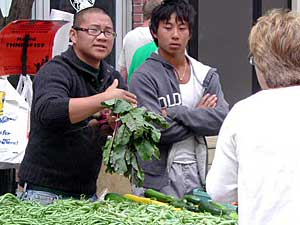|
Photos
More from MPR
Your Voice
|
Hmong in Minnesota still face language and cultural barriers
July 23, 2003
 |
| Joseph Heng, 21, works his family's stall at the downtown St. Paul farmers market. He's a Brown University architecture student, back home on summer vacation. (MPR Photo/Art Hughes) |
St. Paul, Minn. — It's Farmers Market day in downtown St. Paul. Joseph Heng, 21, sells green beans, red potatoes, dill and cucumbers grown on a three-acre plot his family tends in Rosemount. Heng says he helps out when he can.
"Ever since I was a little kid my parents have always been doing the farmers market. Even though I've been away for college, I come back here just to help my parents out for the summer," Heng says.
Heng wears fashionable glasses and an easy smile. It's no stretch for him to invoke the simpler village life his parents led in Laos, and what it means for his life here.
 | |||
"The Hmong people are primarily an agrarian society and so this is something they're used to, something they can do, something they're good at. So they're just going to translate what they know from Laos here to the states, you know," Heng says.
Like many Hmong, Heng's parents fled Laos after the Vietnam War and arrived in Minnesota. Now Heng is an architecture student at Brown University in Rhode Island. He says he's fortunate to have grown up in St. Paul.
"There's educational opportunity, business opportunity, higher education. There's opportunity like the farmers market here. There's political opportunity as well as social opportunity," Heng says.
New numbers released by the U.S. Census Bureau show not all of the state's Hmong are able to clear the language and cultural barriers that have hampered them since they began arriving in significant numbers in the '70s. Thirty-three percent of the state's Hmong live below the federal poverty line. That's compared to 19 percent of all Minnesota Asians in poverty, and just eight percent of the state's total population.
Like Heng, many Hmong prize education as a way to help them succeed, yet only 14 percent have at least a high school education. Minnesotans in general have a high school education rate more than three times that.
|
They came here with virtually nothing in terms of property. They bootstrapped a lot of this economic growth and they've done it, it looks like, through education and hard work.
- Art Rolnick, Federal Reserve researcher |
In addition, the median family income for all Asians living in Minnesota approaches the number for Minnesotans in general. But the median income for the Hmong is only two-thirds of the way there -- not even $37,000.
Art Rolnick, senior vice president of research and public affairs at the Minneapolis Federal Reserve, says Hmong may appear to struggle compared to other American families. But he maintains they've done very well in relation to where they came from.
"They came here with virtually nothing in terms of property. They bootstrapped a lot of this economic growth and they've done it, it looks like, through education and hard work," Rolnick says.
The Federal Reserve released a survey of Hmong businesses last year that shows despite barriers, Hmong appear to access credit with the same frequency as their white counterparts. Rolnick says the Hmong don't have a word in their language for "bank." He says he expects to see the high poverty rates for Hmong diminish over time.
Fue Heu is associate director of the Hmong American Partnership. He says the high poverty rates but low unemployment numbers reaffirm his belief that most Hmong have jobs, just not high-paying ones. He watched his father go from being a highly paid military officer in Laos to a slaughterhouse line worker in this country. He says that provided motivation to overcome obstacles.
"Nobody knows about college. No role model came out there who said, 'This is how you have success in this country, this is how you apply for college.' Everything was brand new. And you stumble and fall, but you always had this goal that I got to be better," Heu says.
Heu says he's concerned the generation of Hmong born in this country won't have the same sense of purpose to motivate them.
About 43,000 Hmong live in the state. The population more than doubled in the 1990s. The census says 57 percent are foreign born, while 31 percent were born in Minnesota. Seven percent came to Minnesota after first living in the western United States.
The numbers are derived from the long Census form that about one in six people filled out in 2000.
|
News Headlines
|
Related Subjects
|
